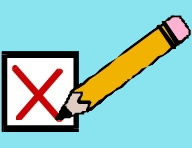
Number Tellers
To find out if known supporters are going to the polls and voting the parties position tellers outside the polling stations who ask voters as they arrive, or in some areas as they leave, what their poll number is. The poll number is on the voter’s polling card and although they don’t have to take it with to the polls in order to vote most people do. This number is noted down on a pad of paper.
One of the strangely positive features of UK politics is that the tellers of all parties co-operate in this function so if someone refuses to give you their number but lets the teller of another party know, they will share that information with you as soon as the person leaves. Your tellers should also co-operate in this manner so if they are inexperienced at telling, let them know this as the last thing you need is a complaint from one of the other parties as you just don’t have the time for it.
The pads used should have tear off sheets and once in a while the committee room organiser, probably you, will send someone from the committee room to pick up the sheets from the teller and return them to the committee room. In these hi-tech days mobile phones and texting could be used but the principle is that the poll numbers get back to the committee room somehow and in good time. The committee room organiser then checks the numbers on the sheets against the polling numbers of your supporters on the knock-up sheets and scores out or removes in some way any who have now voted. During the course of the day your outstanding number of supporters who have not yet voted should decline.
If you are truly serious about the election you will want to have a teller on each polling station from the opening of the polls which is 7am for General and European elections and 8am for local elections until the polls close. You therefore need to set up a rota of tellers. A copy of the rota should be given to the first teller so that they know who is taking over from them and this should be handed on to each subsequent teller.
The period a teller can sit for should only last about two hours as a maximum and during busy times this may need to be shorter. Tellers should wear a rosette or something else that identifies that they are acting on behalf of your candidate. The rosette can be passed from teller to teller as they hand over. Ask your tellers to report back to the committee rooms at the end of their shift and offer them some refreshments. This ensures three things;
1, your tellers can be thanked for their efforts by the committee room organiser or the candidate or both; these people have given up their free time for you so show that you appreciate it;
2, they can bring their completed number sheets back with them saving you sending a knocker-up to collect the numbers and,
3, you can be sure that the next person on the list has arrived.
If you have worked with limited resourced and not canvassed any part of a polling district there is little point in have number tellers, however if you have resources available on Election Day you may want to send a teller to the polling stations as this gives your party or campaign an equal presence with the other parties in the view of voters. This is not uncommon amongst even the major parties as their absence is usually more noticeable then their presence so sending along a teller, even it is only during busy times, can be a damage limitation exercise.
Continue to Knocking Up....